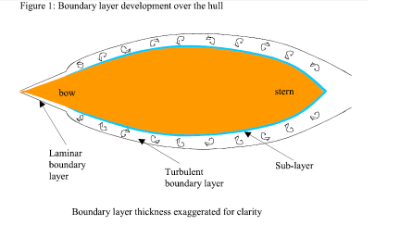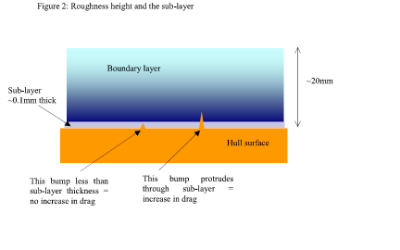Smooth as a baby’s bottom?
A smooth underwater finish will reduce drag, increase speed and improve fuel consumption. Is the bottom of your boat smooth enough?
If you get a group of 5 boaters to sit around the table with a jug of beer to decide on how smooth the underwater part of their boat should be, you can be confident of getting at least 6 different answers. How important is it? What is happening to the water as it flows over the hull? What about the latest non-stick technology, or whether to wax the surface? Aren’t dolphin skins supposed to be the best surface of all? Here you will find answers to those questions, using a bit of science and just a few facts.
A few preliminaries first, just to set the scene. We are talking about frictional drag here, which is just one of the many sources of drag that slows your boat down (other types of drag include wavemaking drag and trim drag). When the water flows past the hull, the water particles right next to the hull surface end up being carried along with the boat. The layer of particles just outside the first layer is also dragged along with the boat, though not quite so fast. The next layer out is dragged along even less, and so on until at some distance out the water particles are not affected at all. The effect is analogous to taking a pack of playing cards and throwing them onto a table. The table is the equivalent of your hull and the cards are the layers of water moving past it.
Each card sticks a bit to the next one. The layers of water next to the hull that are affected by the hull moving forwards is called the boundary layer (see figure 1). It is very thin – less than 50mm in most circumstances – so it is not readily visible unless you are really looking for it. However, it is this boundary layer of water, and what goes on inside it, that is the key to understanding how the hull surface roughness affects the performance of your boat.
There are broadly speaking two types of flow inside the boundary layer – laminar and turbulent. Laminar flow is when the water particles slip smoothly over one another, rather like the pack of cards do. Turbulent flow is when the water particles are moving around randomly, with layers mixing together and particles crossing each others’ paths. Laminar flow has much less drag than turbulent flow bit it only exists on really smooth surfaces, at slow boat speeds, at short distances from the bow (or leading edge ofthe keel), in calm water.In other words we can just about forget entirely about laminar flow except for the keels of a few very well-cared for racing yachts. And even then it will only be laminar when you are not sailing in waves. To quote America’s Cup designer Dave Pedrick “We’ve used electronic sensors and microphones to test for laminar flow. You can get some, but not much”. So let’s concentrate on turbulent flow.
Inside this thin boundary layer of turbulent flow there is an even thinner layer of water, called the sub-layer (scientists can be an unimaginative bunch at times). The sub-layer is really thin, typically less than O.lmm or the thickness of a human hair. It is difficult to imagine that this wafer-thin layer of water is so influential, but it is. H the roughness of the hull surface is high enough to protrude through the sub-layer, it will cause an increase in frictional drag i.e. slow you down. The more it protrudes, the more the friction. If the roughness is less than the sub-layer thickness, you have what is known as a hydraulically smooth surface, and making the surface any smoother won’t reduce the drag further no matter how much sanding you do (see figure 2). So we now know how smooth the hull should be -no rougher than the sub-layer thickness. The sub-layer thickness depends on the speed of the boat and how far back from the bow you are looking at. As you move aft along the boat from the bow, so the sub-layer thickness increases. However, at any chosen point on the boat the sub-layer thickness DECREASES as boat speed increases. So the hull must be smoothest near the bow, and it has to be smoother for high speed boats than for low speed boats. A typical brush-painted finish is about three times rougher than typical sub-layer thickness. As a guide, using 360 grade sandpaper will usually get you a hydraulically smooth surface. This does not mean that if you give the hull a going over with 360 grade, you will have a hydraulically smooth surface. You have to work steadily through the various grades from rough to smooth. It is however a law of diminishing returns, so we need to know whether the effort in sanding the hull is better used practicing sailing, or working to pay for more fuel.
How important is hull roughness? The difference between a typical brush-painted surface and a thoroughly and carefully 360-grade sanded hydraulically smooth surface can be about 3% in boat speed. On a racing yacht this means a 3 minute advantage on a Saturday afternoon race, and on a cruising yacht it means arriving 45 minutes earlier on the Quindalup cruise. On a power boat it will save you enough fuel to pay for a fair few rounds of drinks. Weed or barnacles on your hull will increase the roughness considerably, so you lose all the gains made if you let anything grow on your carefully sanded hull.
Finally, let’s examine a few bar-stool philosophies. First, if your underwater finish allows water droplets to “bead” rather than “pool”, is this a low friction surface? Beading of water droplets has nothing to do with water friction, it is a surface tension effect. Products that encourage beading are unlikely to make the surface smoother. (However, they might discourage marine growth from sticking to the hull, so in that sense they may reduce hull roughness).
Second, is waxing a hull going to reduce drag? No, for similar reasons – the wax is probably going to introduce small lumps to the surface, and it will attract dirt – remember we are trying to get roughness down to less than the thickness of a human hair.
Third, what about the dolphin-skin concept? It is true that dolphins have less drag than an object of that shape should have. Their skin is soft and flexible, allowing it to absorb some of the turbulence in the boundary layer over the dolphin, so there is more laminar flow over the dolphin, hence less drag associated with it. Researchers have been investigating dolphin-skin surfaces, called compliant surfaces, for about 30 years, but are not yet able to apply the technology to yachts.
What about sanding down a gel coat finished underwater hull surface? Well, you get the same friction reduction as with any other surface, but you will increase the porosity of the gel coat, increasing the likelihood of water absorption and hull laminate breakdown. Doesn’t sound like a good idea to me; better to put a paint system on, then rub that down.
Finally, what about the various antifouling finishes now available? In essence the same principle applies- the paint system that gives you the smoothest finish has the least drag. It’s how that level of smoothness is achieved that distinguishes the different options (self-polishing, sandable, easy-clean non-stick etc.). And that is a whole new can of worms (pardon the pun) best left for another time.
Quick guide:
- Any marine growth is bad news.
- Brush painted finish is not nearly smooth enough; aim for roughness height less than a human hair.
- If sanding, work through grades to 360.
- Don’t waste time using 360 grade if you have 80 grade-sized roughness-get rid of the big bumps before working on the little ones.
- Most important areas are near the bow, and on keels and rudders.
Further reading:
Garrett, R (1987) The symmetry of sailing, Adlard Coles, London.
Larsson, L. and Eliasson, R E. (1994) Principles of yacht design, International
Marine, Camden.
Marchaj, C. A. (1979) Aero-hydrodynamics of sailing, Granada, St. Albans, UK.



No comments yet.